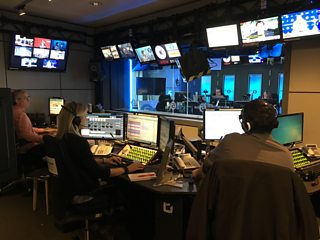Tearing up the running order: what it's like as a Radio 5 live producer
Simon Coe
Senior Producer, Βι¶ΉΤΌΕΔ Radio 5 live Drive
Tagged with:

I get in around 8am, an hour before the rest of the Drive team. We generally have a blank canvass with nothing in the programme apart from the odd pre-planned piece, so we’ve got nearly three hours of radio to fill each day.
After looking at the stories doing the rounds in the morning and online, there’s a meeting at 8.30am with the other editors and senior producers of 5 live programmes and we discuss what’s on the news agenda and what the other programmes are doing.
The rest of the team gets in at 9am, and we meet to talk about their ideas for the programme, and what guests to speak to. A reporter or presenter might go out on location if there’s big, breaking news.
Then it’s a matter of bashing the phones and working on stories. If it’s a company or organisation we tend to approach a press office for people to interview, but with social media these days people who may not have been so easy to get hold of in the past can be contacted a lot more easily and directly.
Our lead story is put at the top of each hour, and if it’s big enough we might do it on the half-pasts as well. That’s about the only structure, other than at 6.30pm where every day we spend the last half hour on one story with three or four guests. Presenters Tony Livesey and Sarah Brett will ask questions, but it’s all very relaxed and conversational.
With an event like the death of Aretha Franklin, it’s a matter of tearing up the running order and starting again. When that happens, everything just sort of works - everyone very quickly is made aware of what their role is in the process as pretty much the whole team will be working on it, and it works like a well-oiled machine.
It happens quite a lot, having to react to breaking news and making decisions on what you’re going to lose to accommodate what comes in - I don’t drink coffee, but get through lots of tea! Though I try to stick to decaf tea now.
We’re on 4-7pm, but the show is still very much a work in progress as you’ll have producers during the first hour working on pieces for later on.
At 7pm we’re off air and chat about what went well what went not so well, then it’s home time.
When Prince died, it was late on in the programme and we stayed on air later. It was a rolling news operation, providing updates when they came in. If there’s a big story we’ll stay on, for example with some of the awful terror attacks.
It’s not just sound and radio, as we’ve massively increased our digital coverage, so that means sourcing and uploading pictures and video as well.
On Drive, the stories and issues reflect a broadening of the audience to include younger listeners, young families and students, and with more diverse voices on air, more women, younger people, and from different backgrounds.
5 live is one of the biggest newsrooms outside London, so it’s important to also report from parts of the UK that don’t always get the coverage that they should, and in Salford it’s easier for us to get out to different parts of the country.
Ultimately, it’s not all about serious news. We like to put a smile on our audience’s faces every day and like them to get involved, we get great responses through texts and tweets, so it’s a nice mix.
Drive is broadcast on Βι¶ΉΤΌΕΔ Radio 5 live 4-7pm, Monday-Friday.
